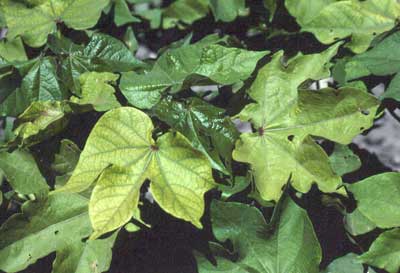Issue 2 Table of Contents

|
FEATURED ARTICLEAgronomy and Soils Genetic Variation for Waterlogging Tolerance in Cotton W.C. Conaty, D.K.Y. Tan, G.A. Constable, B.G. Sutton., D.J. Field, and E.A. Mamum
Pages: 53-61
Abstract
| Full Text PDF (720K)
Waterlogging can be an impediment to cotton growth on heavy clay soils in Australia, particularly with rain following irrigation. A number of nutrients may be affected during that time, including nitrogen. One symptom that can occur is waterlogging-induced iron chlorosis, where available iron is reduced for a number of days.
Photo by G.A. Constable |
|---|
Issue Editors
|
Agronomy and Soils
Genetic Variation for Waterlogging Tolerance in Cotton W.C. Conaty, D.K.Y. Tan, G.A. Constable, B.G. Sutton., D.J. Field, and E.A. Mamum
Pages: 53-61 Abstract
| Full Text PDF (720K)
Breeding and Genetics
Uzbek Scientific Research Institute of Cotton Breeding and Seed Production: Breeding and Germplasm Resources Paridun Sh. Ibragimov, Victor A. Avtonomov, Alisher B. Amanturdiev, Shadmon E. Namazov, David E. Zaurov, Thomas J. Molnar, Sasha W. Eisenman, Thomas J. Orton, C. Reed Funk, and A. Edward Percival Jr.
Pages: 62-72 Abstract
| Full Text PDF (413K)
Breeding and Genetics
Evaluation of the USDA Shafter Cotton (Gossypium spp.) Collection for Agronomic and Fiber Traits J.X. Zumba, and G.O. Myers
Pages: 73-80 Abstract
| Full Text PDF (200K)
Economics and Marketing
Simulation Analysis of U.S. Cotton Production with ERS Costs and Returns Data A. Flanders
Pages: 81-86 Abstract
| Full Text PDF (485K)
Economics and Marketing
Testing the Efficacy and Economic Potential of Bollgard II under Burkina Faso Cropping Conditions O. Traore, S. Denys, J. Vitale, K. Traore, and K. Bazoumana
Pages: 87-98 Abstract
| Full Text PDF (728K)
Economics and Marketing
Ethanol’s Effect on the U.S. Cotton Industry M. Welch, S. Pan, S. Mohanty, and M. Fadiga
Pages: 99-108 Abstract
| Full Text PDF (437K)
Engineering and Ginning
Seed Coat Fragments, Motes, and Neps: Cultivar Differences J. C. Boykin
Pages: 109-125 Abstract
| Full Text PDF (426K)
|
Engineering and Ginning
Lint Cleaning Performance of a Modified Cylinder Cleaner S. Le
Pages: 126-133 Abstract
| Full Text PDF (260K)
Engineering and Ginning
Multi Scenario Pellet Fuel Manufacturing Operation Utilizing Cotton Waste J. Simonton, G. Holt, M. Beruvides, L. A. Barroso
Pages: 134-142 Abstract
| Full Text PDF (286K)
Engineering and Ginning
Evaluating a Fiberglass Roller Covering on a Roller Gin Stand D.P. Whitelock, C.B. Armijo, and G.R. Gamble
Pages: 143-149 Abstract
| Full Text PDF (184K)
Molecular Biology and Physiology
Photosynthesis, Quantum Yield of Photosystem II and Membrane Leakage as Affected by High Temperatures in Cotton Genotypes A.C. Bibi, D.M. Oosterhuis, and E.D. Gonias
Pages: 150-159 Abstract
| Full Text PDF (478K)
Plant Pathology and Nematology
Seed Transmission of Fusarium oxysporum f. sp. vasinfectum Race 4 in California R.S. Bennett, R. B. Hutmacher, and R. M. Davis
Pages: 160-164 Abstract
| Full Text PDF (172K)
Plant Pathology and Nematology
Development of a DNA-based Macroarray for the Detection and Identification of Fusarium oxysporum f. sp. vasinfectum in Cotton Tissue C.A. Gilbert, N. Zhang, R.B. Hutmacher, R.M. Davis, C.D. Smart
Pages: 165-170 Abstract
| Full Text PDF (176K)
Textile Technology
Method for the Prediction of the Rate of +b Color Change in Upland Cotton (Gossypium hirsutum L.) as a Function of Storage Temperatures G.R. Gamble
Pages: 171-177 Abstract
| Full Text PDF (368K)
|
